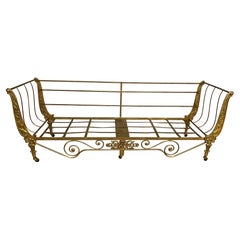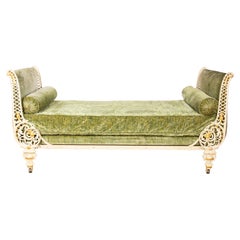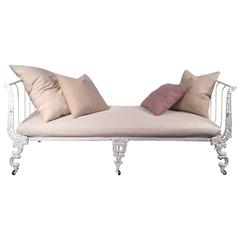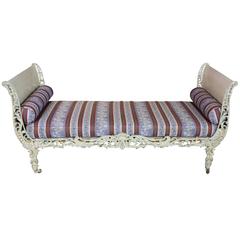Cast Iron Daybed
Antique 19th Century French Napoleon III Daybeds
Iron
Antique 19th Century French Belle Époque Beds and Bed Frames
Iron
Recent Sales
Antique 1860s French Napoleon III Daybeds
Iron
Antique Late 19th Century French Louis XV Daybeds
Iron
Antique 19th Century English Victorian Beds and Bed Frames
Iron
Antique 19th Century English Victorian Beds and Bed Frames
Iron
20th Century French Art Deco Daybeds
Iron
Antique 19th Century French Daybeds
Iron
Antique 19th Century American Victorian Daybeds
Iron, Steel
Antique Late 19th Century French Rococo Daybeds
Iron, Steel
Antique 19th Century French Napoleon III Daybeds
Iron
Antique 19th Century French Daybeds
Iron
Antique 19th Century French Daybeds
Iron, Wrought Iron
Antique Late 19th Century Italian Daybeds
Iron
Antique 19th Century Canadian Daybeds
Iron
Antique 19th Century French Daybeds
Iron
Antique 19th Century French Daybeds
Antique 19th Century French Daybeds
Iron
Vintage 1920s French Rococo Revival Beds and Bed Frames
Iron
Antique Late 19th Century French Napoleon III Daybeds
Iron, Wrought Iron
Antique 19th Century European Art Nouveau Daybeds
Iron
Early 20th Century French Rococo Revival Beds and Bed Frames
Iron, Steel
20th Century French Beds and Bed Frames
Iron
Antique 1860s French Napoleon III Daybeds
Iron
Antique Mid-19th Century French Napoleon III Daybeds
Iron
Antique 19th Century French Empire Daybeds
Antique 19th Century English Campaign Beds and Bed Frames
Antique 1890s French Art Nouveau Daybeds
Iron
Antique 1880s French Napoleon III Daybeds
Antique 19th Century French Campaign Daybeds
Iron
Antique Late 19th Century American Late Victorian Daybeds
Steel, Wrought Iron
Antique Late 19th Century Rustic Patio and Garden Furniture
Wrought Iron
Early 20th Century French Beds and Bed Frames
Iron, Wrought Iron
Early 20th Century Unknown Daybeds
Iron
Early 20th Century French Daybeds
Antique 19th Century French Daybeds
Iron
Antique Late 19th Century Empire Daybeds
Iron
Antique 19th Century French Daybeds
Antique 19th Century French Daybeds
Iron, Steel
Antique 19th Century French Daybeds
Iron
Antique 19th Century Victorian Daybeds
Metal
Early 20th Century French Daybeds
Iron
Antique 19th Century French Daybeds
Iron
Antique 19th Century French Daybeds
Antique 18th Century and Earlier French Daybeds
Iron
Early 20th Century French Daybeds
Iron, Steel
Antique Late 19th Century French Belle Époque Daybeds
Iron
Antique 1860s French Napoleon III Daybeds
Iron
Antique Mid-19th Century English Napoleon III Daybeds
Iron
People Also Browsed
Antique 19th Century French Napoleon III Stairs
Walnut
21st Century and Contemporary Swedish Mid-Century Modern Table Lamps
Textile
2010s American Table Lamps
Brass
Antique Late 19th Century French Louis XVI Beds and Bed Frames
Cane, Walnut, Paint
20th Century French Hollywood Regency Sectional Sofas
Metal
Mid-20th Century French Neoclassical Benches
Bronze, Wrought Iron
Vintage 1950s American American Craftsman Sofas
Poplar, Tulipwood, Walnut
Antique Late 17th Century Belgian Baroque Tapestries
Tapestry, Wool
Antique Mid-19th Century French Bathroom Fixtures
Copper
Antique 19th Century American Beds and Bed Frames
Silk, Mahogany, Oak, Walnut
Vintage 1960s Post-Modern Daybeds
Steel
21st Century and Contemporary Asian Modern Benches
Wood
Vintage 1960s French Daybeds
Elm
Early 20th Century French Art Deco Architectural Elements
Early 20th Century Italian Neoclassical Daybeds
Cane, Hardwood, Paint
21st Century and Contemporary Portuguese Modern Sofas
Velvet, Wood, Silk, Trimming
Cast Iron Daybed For Sale on 1stDibs
How Much is a Cast Iron Daybed?
Finding the Right Day-beds for You
An antique or vintage daybed is a practical solution for furnishing any modest-sized bedroom or guest room and can even be a versatile option for the reading nook in your living room.
Daybeds, which traditionally comprise a simple three-sided frame and twin-size mattress or boxy foam cushion, have a long history that dates back at least to the early Greeks and Romans. The spare construction and multipurpose nature of these multifunctional marvels — they’re not loveseats, sofas or chaise longues, but each share some commonalities — have over time rendered them an easy and often essential piece of seating.
All manner of daybeds have materialized over the years. There are ornate, unconventional versions created in the Louis XV, Art Deco and Empire styles, while popular mid-century modern iterations include the Barcelona daybed, designed by Ludwig Mies van der Rohe and Lilly Reich, as well as the Nelson daybed, which architect George Nelson created for Herman Miller in the 1940s. But you don’t have to limit yourself to one of the classics.
Variations on the daybed have been developed all over the world, and contemporary examples come in all shapes, upholstery options and sizes. (They’re no longer limited to twin size.) No matter what style you choose, this luxury furnishing ensures that you don’t have to wait until nighttime to start dreaming.
On 1stDibs, find a cozy collection of antique, new and vintage daybeds today.
- 1stDibs ExpertMay 3, 2024The difference between iron and cast iron comes down to content. Iron is generally pure iron, a chemical element that is a solid metal at room temperature. Cast iron is a mix of iron, carbon, silicon, manganese, sulfur, phosphorus and other elements. Both iron and cast iron can be used to produce furniture, cookware, decorative objects and other items. Generally, cast iron is heavier than iron. Shop an assortment of iron and cast iron pieces on 1stDibs.
- Who invented cast iron?1 Answer1stDibs ExpertMay 3, 2024The name of the person who invented cast iron is unknown. However, anthropologists and archaeologists have determined that the ancient Chinese were the first to develop it. The earliest known examples of cast iron date back to the 6th century B.C. Cast iron production didn't begin in Europe until the 14th century A.D. Shop a collection of cast iron furniture and decorative objects on 1stDibs.
- What are cast iron columns?1 Answer1stDibs ExpertMay 5, 2023Cast iron columns are vertical supports produced out of cast iron, a material made from iron and alloys with a carbon content of more than two percent. During the 19th century, cast iron columns were used in architecture. Today, they primarily function as decorative objects. Shop a range of cast iron columns on 1stDibs.
- Are cast iron columns hollow?1 Answer1stDibs ExpertMarch 31, 2023Whether cast iron columns are hollow depends on the piece. Most cast iron columns are hollow due to the manner of crafting, but some are solid. On 1stDibs, find a selection of columns.
- 1stDibs ExpertFebruary 17, 2023Yes, you can generally use cast iron as a planter because the material is durable and sturdy. However, you may need to drill drainage holes in a cast iron piece that wasn't intended to function as a planter to allow excess water to exit the vessel. On 1stDibs, find a selection of cast iron planters.
- Do cast iron tables rust?1 Answer1stDibs ExpertMay 5, 2023Yes, cast iron tables can rust. Pieces are more likely to develop rust when exposed to humidity, such as in bathrooms or outdoor living spaces in coastal areas. Wiping surfaces clean regularly and touching up scratches and chips can reduce the risk of rust. On 1stDibs, shop a selection of cast iron tables.
- Do cast iron Firebacks work?1 Answer1stDibs ExpertAugust 24, 2021Yes, cast iron firebacks are quite sturdy and work really well. As they are made of solid iron, it's a challenge to move and place them. Given that, cast iron firebacks are the best protection for the back wall of the fireplace. Find a variety of firebacks on 1stDibs.
- How do I hang a cast iron bell?1 Answer1stDibs ExpertMarch 22, 2022How to hang a cast iron bell depends on the style. Some cast iron bells have loops at the top that you can hang from a hook anchored onto your desired mounting surface. Others have brackets or frames that you can secure with mounting screws. On 1stDibs, shop a selection of cast iron bells.
- 1stDibs ExpertSeptember 25, 2019
To keep a piece made of cast iron from rusting, place it in a cool, dry space with good air circulation.
- 1stDibs ExpertMarch 22, 2022Cast iron doorstops originated in the late 18th century. Osbourn Dursey invented the first doorstop in 1878. Decorative cast iron stops became popular in the 1920s and remained so throughout World War II. On 1stDibs, shop a variety of antique cast iron doorstops.
- 1stDibs ExpertSeptember 25, 2019
Cast iron is stronger than steel.
- 1stDibs ExpertMarch 22, 2022A cast iron fireplace insert is a firebox that fits into an existing fireplace surround. The insert is made of cast iron, a type of iron that is more than 2 percent carbon. Cast iron is highly durable and very resistant to the effects of heat. You'll find a selection of cast iron fireplace inserts on 1stDibs.
- 1stDibs ExpertAugust 17, 2021Cast iron trivets are used for many things but are especially ideal for slow cooking meat. They can prop up food in Dutch ovens to prevent burning and increase heat distribution.
- When were cast iron beds made?1 Answer1stDibs ExpertFebruary 22, 2021Cast iron beds were made starting in the 1850s. These types of beds were handmade until World War I through the use of molds.
- Does cast-iron furniture rust?1 Answer1stDibs ExpertSeptember 25, 2019
Yes, cast-iron furniture rusts.
- 1stDibs ExpertMarch 31, 2023Cast iron is often used for benches because of its characteristics. Its strength makes it well-suited to support the weight of two or more adults, and its hardness allows it to resist damage due to weather exposure. Shop a range of cast iron benches on 1stDibs.
- 1stDibs ExpertApril 5, 2022Cast iron is frequently used for fireplaces due to its properties. The metal is highly durable, allowing it to hold up to the effects of frequent use. It also readily conducts heat to help warm up interiors. You'll find a variety of cast iron fireplaces on 1stDibs.
- 1stDibs ExpertSeptember 25, 2019
Unlike cast iron, wrought iron is not brittle and will bend rather than break. Wrought ironwork is produced with a hammer and anvil and tends to be more intricate than cast ironwork, which is characterized by repetitive designs that can be carved into a wooden pattern and cast.
- 1stDibs ExpertJune 30, 2023To tell if a cast iron doorstop is valuable, always look for original paint. Any that have been repainted or repaired will have diminished in value. You can also use online resources to try and research items, but the best way to find out if a cast iron doorstop is worth anything is to consult a certified appraiser. An experienced professional can evaluate the condition, determine the maker and research the piece to assign an approximate value. On 1stDibs, find a range of doorstops.
- 1stDibs ExpertMay 5, 2023Whether cast iron is good for outdoor furniture is largely a matter of personal opinion. However, many people prefer cast iron due to its strength, durability and timeless Old World charm. On 1stDibs, find a collection of cast iron outdoor furniture.
Read More
All the Furniture in This Organic Modern Soho Loft Can Be Yours
Andrianna Shamaris has filled her epic new home with pieces of her own design.
20 Inviting Dining Rooms Perfectly Arranged for Entertaining
Top interior designers show — and tell — us how to create delectable spaces for hosting dinner parties.
Nobody Puts This Sunny Sofa in a Corner
With its plush cushions, cane details and dazzlingly colorful back, it’s inviting from every angle.
The 21 Most Popular Mid-Century Modern Chairs
You know the designs, now get the stories about how they came to be.
Fred Rigby’s Modular Seating Can Be Configured in So Many Handy Ways
The plush Cove Slipper 2.5 Seater sofa is just one of many convenient combinations from the London-based maker.
This Chubby-Chic Quilted Stool Stands on Its Own Two Feet
Sam Klemick's cool stool is edgy, cozy and environmentally sustainable all at once.
Is Lionel Jadot the Willy Wonka of Upcycled Belgian Design?
From his massive collaborative workshop in a former paper factory, the designer concocts funky furniture from disused materials, as well as luxe hotel interiors like the new Mix Brussels.
Rock Your Cares Away on This Sunny Hand-Crocheted Swing
The boho-chic Enchanted Forest Swing, handmade by marginalized women from Turkey and Syria, is uplifting in every way.



